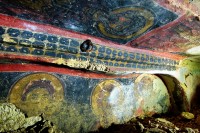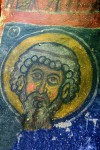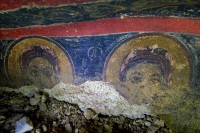 Archaeologists excavating the vast networks of rock-cut caves underneath the massive Byzantine-era castle in the town of Nevşehir, Central Anatolia Region, Turkey, have discovered an ancient church with unique frescoes depicting Biblical scenes not seen before in other churches of the period. Preliminary estimates suggest the church dates to the 5th century and the frescoes that have been revealed so far — on the ceiling and very tops of the walls — are still in brilliant color. There are scenes of Jesus’ crucifixion, the Ascension, saints and Old Testament prophets including Moses and Elijah.
Archaeologists excavating the vast networks of rock-cut caves underneath the massive Byzantine-era castle in the town of Nevşehir, Central Anatolia Region, Turkey, have discovered an ancient church with unique frescoes depicting Biblical scenes not seen before in other churches of the period. Preliminary estimates suggest the church dates to the 5th century and the frescoes that have been revealed so far — on the ceiling and very tops of the walls — are still in brilliant color. There are scenes of Jesus’ crucifixion, the Ascension, saints and Old Testament prophets including Moses and Elijah.
Nevşehir Mayor Hasan Ünver said the frescoes in the church showed the rise of Jesus the Christ into the sky and the killing of the bad souls.
“We know that such frescoes have so far never been seen in any other church,” Ünver said[….]
“It is reported that some of the frescoes here are unique. There are exciting depictions like fish falling from the hand of Jesus Christ, him rising up into the sky, and the bad souls being killed.”
That reference to bad souls being killed is not clear to me. It could be the Last Judgement, I suppose, but the souls of the wicked are damned, not killed. They wish they were killed! That’s kind of the whole point of Hell. I wonder if it’s a reference to the Harrowing of Hell derived from 1 Peter 3:19-20 that refers to Jesus preaching to evil souls/spirits (ie, Luciferian demons, rather than the souls of dead people) imprisoned in Limbo/Hell/Hades. It was a popular theme in Orthodox art. In fact, it first appears in Orthodox art significantly earlier than in Catholic art. The Western tradition appears to have only begun to borrow it from the Orthodox in the 8th century.
 The underground city of Nevşehir was first unearthed in 2014 and while several other towns in the region, most famously Göreme, are known for their ancient rock-cut tunnel systems, the one in Nevşehir is believed to be the largest covering an area of 360,000 square meters with some tunnels more than four miles long. People have been beehiving under this place for an estimated 5,000 years. They cut out everything from water conduits to private dwellings to hermit cells and Christian churches. Nevşehir Castle Urban Transformation Project has been excavating the tunnels underneath the castle and 11 neighborhoods in the old town center. They’re excited at the prospect that the discovery of such early frescoes with unique iconography could make Nevşehir a site of pilgrimage for Orthodox Christians.
The underground city of Nevşehir was first unearthed in 2014 and while several other towns in the region, most famously Göreme, are known for their ancient rock-cut tunnel systems, the one in Nevşehir is believed to be the largest covering an area of 360,000 square meters with some tunnels more than four miles long. People have been beehiving under this place for an estimated 5,000 years. They cut out everything from water conduits to private dwellings to hermit cells and Christian churches. Nevşehir Castle Urban Transformation Project has been excavating the tunnels underneath the castle and 11 neighborhoods in the old town center. They’re excited at the prospect that the discovery of such early frescoes with unique iconography could make Nevşehir a site of pilgrimage for Orthodox Christians.
Nevşehir was in what had once been the kingdom of Cappadocia, absorbed into the Roman Empire by Tiberius in 17 A.D. The tunnels were used as catacombs during the thornier years of Christian persecution, but the practice of cutting whole churches out of the rock grew out of the 4th century anchorite tradition. Cappadocia was an important center of Church thought in the 4th century, known particularly for the Cappadocian Fathers, Basil the Great (bishop and saint), Gregory of Nyssa (bishop and saint) and Gregory of Nazianzus (archbishop and saint), who sought to introduce the Greek philosophical rigor to Christian theology. It was Saint Basil who encouraged the development of nascent anchorite communities where people who wished to withdraw from the world could dedicate the rest of their lives to penance and prayer. In the Nevşehir area, the anchorites made cells for themselves by digging them out of the soft rock. Over time the underground monastic communities carved themselves out increasingly large and elaborate churches.
 Right now excavation has been halted because of excessive humidity which is deadly to ancient frescoed walls. The space must be dried gradually to ensure there is no paint loss or fading. From what has already been exposed, archaeologists can see that whole sections of the frescoed walls have collapsed inward, likely due to rain and snow. They hope the fragments may be recoverable in the fill, but won’t be back until the weather warms up this spring and all the moisture has evaporated. At that point they will continue removing the earth, hopefully discovering restorable pieces of the wall paintings or, in the best case scenario, sections of intact side walls as they dig down.
Right now excavation has been halted because of excessive humidity which is deadly to ancient frescoed walls. The space must be dried gradually to ensure there is no paint loss or fading. From what has already been exposed, archaeologists can see that whole sections of the frescoed walls have collapsed inward, likely due to rain and snow. They hope the fragments may be recoverable in the fill, but won’t be back until the weather warms up this spring and all the moisture has evaporated. At that point they will continue removing the earth, hopefully discovering restorable pieces of the wall paintings or, in the best case scenario, sections of intact side walls as they dig down.
Once the church is fully excavated, we’ll know its dimensions — right now we can’t even tell how high it is — and get a glimpse of what may prove to be very significant early and transitional iconographic elements in the history of Byzantine art.